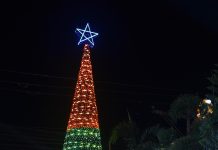Text and Photos by Henrylito D. Tacio
Bansalan — in the northwestern part of Davao del Sur — earned the moniker “green town” for various reasons. For one, it is the home of the world famous Sloping Agricultural Land Technology (SALT), a sustainable farming system for the uplands developed by Mindanao Baptist Rural Life Center (MBRLC) in barangay Kinuskusan.
MBRLC is touted as the “Disneyland of organic farming.” Aside from SALT, it has developed three more modifications of the systems: Simple Agro-Livestock Technology (SALT 2), Sustainable Agroforest Land Technology (SALT 3) and Small Agrofruit Livelihood Technology (SALT 4).
The center has also come up with a sustainable gardening scheme called Food Always In The Home (FAITH). In the region, MBRLC is also called the “goat center of the province” as it started raising goats since it opened to the public in 1971.
Because of the technologies it has developed through the years, the MBRLC is one of the most-often visited farms in Mindanao. People from all over the world – from Australia to Zimbabwe, from Afghanistan to Vietnam, from United Kingdom to United States – have come at the center.
And for encouraging international utilization of SALT and other farming schemes, MBRLC’s former director, Harold R. Watson, was honored a Ramon Magsaysay Award in 1985 for peace and international understanding.
MBLRC is located about 10 kilometers away from the town proper. About five kilometers away from the center is another organic farm named Lao Integrated Farms, Inc. The owner, Benjamin R. Lao, uses coconut to produce coco sugar. He does not only sell his coco products in his hometown and nearby areas but also export them to other countries.
Aside from coconut, the Lao farm is also teeming with various fruits like lanzones (more than a thousand trees), durian (700 trees), mangosteen, and rambutan. “I bought them one at a time from my salary as a government employee,” said Lao, who used to work as immigration officer.
In his farm, you won’t see his farm workers using chemical pesticides. “I had a tragic experience with chemical pesticides when I was still a teenager while cultivating rice in our farm located at the neighboring barangay,” he revealed.
The Lao farm is about three kilometers away from the national highway. If you go further, to another barangay called Bitaug, you will find the home of the late Salinta Monon, the last Bagobo weaver.
In 1988, the National Commission for Culture and Arts (NCCA) had recognized her as a Gawad Manlilikha ng Bayan (GAMABA) in acknowledgement of her priceless contribution to the country’s art and culture by weaving “ikat,” a cloth made from abaca fibers. She died peacefully in 2009.
But before she died, I had the opportunity of meeting her. In an interview, she told me that it would took her three to four months to finish a fabric that measures 3.5 meters by 42 centimeters in length. One abaca tube skirt can be finished within a month. “It takes time but the result is great,” she said.
Bansalan is also one of three gateways of Davao del Sur to Mount Apo; the other two are Digos City and Santa Cruz. A few years ago, when Kidapawan City in North Cotabato closed its pathway going to Mount Apo, most mountain climbers came to Bansalan to scale the country’s highest peak.
Mountain climbers had to pass the captivating barangay of Balutakay. Serene, good fertile lands, and cool weather, Balutakay is good for high value crops like cabbage, carrots, onions, and lettuce. Farmers plant these crops following the contours of the mountain.
If Cebu has Sinulog, Bansalan has Dorongan. It is celebrated during the third week of January. People from various barangays bring with them the statue of Sto. Niño and dance their way after the celebrated Mass.
Some schools — high school and elementary — participate in the festivity by doing a colorful and lively presentation through dance and music. It is one of the most anticipated events during the celebration.
But the biggest event comes when the town celebrates its anniversary in September. Bansaulog is its answer to Davao City’s Kadayawan. “Bansaulog comes from two words,” explains Geraldine Hope E. Batal, the town tourism officer. “From Bansalan, the word ‘bansa’ is taken from. Saulog is actually a local term for celebration. As such, Bansaulog simply means Bansalan celebration.”
A day before the town anniversary — on September 17 — the roads are closed for the street dancing festivity called “Sayaw sa Kadalanan.” Again, elementary pupils and high school students strut their way and show their well-choreographed moves.
But before that, people flock to the ABC Gym where Folk Dance Contest is being held. Again, several schools, both from government and private, participate in the competition. “We want the younger generations today that we have a very colorful and lively culture. They need to see how tinikling, itik-itik, pandango sa ilaw, and other folk dances are being performed,” Batal said.
There is an interesting story on how Bansalan got its name. The Provincial Tourism Development Plan shares this information: “Bansalan got its name from the one simple farmer named Bansalan who one day dug the earth in search of potable water to quench his thirst. Fortunately, he dug a spring which didn’t satisfy his thirst but also his other companions. Rain widened the spring and the constant erosion of soil led to its formation into a creek, and later into a river. Bansalan did not live long. His companions, who were recipients of Bansalan’s labor named the river after him.”
To get to Bansalan, you have to ride a bus or van going to Cotabato City. It is about 75 kilometers away from Davao City. You have to pass by the oldest town of Sta. Cruz and Digos City before reaching the place. Travel time is about one-and-a-half to two hours.
0 Comments
Oldest






